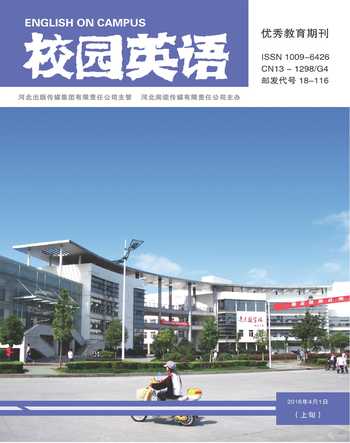An Adaptation from a Functional Perspective
2016-07-04丰志明吕凯
丰志明 吕凯
【Abstract】According to functional theory of translation, adaptation is an acceptable translation form which focuses on communicative purpose of the target text. The paper briefly explains functional theory and adaptation, and in detail analyzes an adaptation from a functional perspective.
【Key words】functional theory of translation; adaptation
1. Introduction
Functional theory of translation was put forward by K. Reiss, H. J. Vermeer, J. H. Manttari and C. Nord in Germany in 1970s, and K. Reiss is the founder who gave a paper in which textual function is considered to be a criterion of translation criticism, and relationship between function of source text and that of target text is the basis of translation criticism. Functional theory of translation originated in communicative theory and its core is Skopos theory which refers to the purpose of the target text (Nord, 2001:28). Thus translators should, first of all, think about function of target text, caring for social and cultural background of the target readers and communicative needs of target text, and then consider translation methods and comprehension of source text. This is a “top-bottom” translation procedure which is different from the ordinary “bottom-up” one. So its translation criterion is that whether the target text reaches the goal of translating or not (Cheng Hai-yan, 2005: 73).
2. Functional Theory of Translation
H. J. Vermeer, the student of K. Reiss, made a great contribution to functional theory of translation by developing Skopos theory. According to it, translating should abide by three rules. First, Skopos rule. The whole translating procedure including the choice of translating methods and translating strategies is determined by purposes of translating action. Purposes are divided up into three types: translators purpose, communicative purpose of target text and purpose achieved by using special means. Among them, communicative purpose is generally more important than the others and usually decided by initiators of translating action. Translators, however, could take part in the decision on it. Second, Coherence rule. Target text must conform to the criterion of intratextual coherence. Third, Fidelity rule. Target text and source text should be intertextual coherence (李文革, 2004: 139-140).
3. Adaptation
Adaptation is a form and method of translation. The translator and compiler does translating and editing at the same time, and is required to not only have good reading, analyzing and synthesizing competence in source text, but also be able to reproduce the meaning of source text faithfully and smoothly in target text. To some extent, translator changes the content and form of source text in order to suit particular readers needs. Accordingly some scholars insist adaptation is not idiomatic translation. However, there are many scholars who consider it a method of translation and of whom C. Nord is one. She thought any translation contains compiling components and adaptation is an expression of Skopos theory (Nord, 1991: 29-30). Since the translator and compiler needs to achieve a certain communicative purpose, target text has to break the limitation of source text.
4. An Adaptation Analysis from a Functional Perspective
The adaptation used here is “Brief Introduction of College” which is in the recruiting brochure of the International College of Sichuan Normal University. The case is a Chinese-English translation.
A. Source Text Analysis
a. Translation purpose: The target text is used for publicizing the college in order to recruit students.
b. Target readers: They are candidates for college entrance examination and their parents. They are graduating from senior middle school and their English level is limited. As for the generation of their parents, most of the people know little English mainly for historical reasons. Consequently, both of them most likely choose to look for the information in the Chinese version rather than the English version. In other words, they read the English version only for reference.
B. Translation Strategies Analysis
Adaptation is employed to translate the article. This strategy accords with Nords instrumental translation which focuses on a new communicative interaction between the source-culture sender and the target-culture reader, and conveys practical content of the source text on the basis of target readers need.
C. Analysis of Wording
Choice of words determines the style of target text. To cautiously select words is to be responsible for target readers. One example from “Brief Introduction of College” is: “按現代化标准设计建造的教学大楼和国际教育交流中心总面积达18800平方米” is translated into “The new Teaching Hall and the International Education-Exchange Center”. The word “occupy” is better than any other one for it rationalizes the structure of the current sentence best.
D. Reorganizing
In adaptation, reorganizing structures and redistributing information are very common (Zhang Mei-fang, 2004: 98).
a. Unite and separate: There are 4 paragraphs in target text, while 6 in source text. To be exact, the 1st paragraph is divided into 2 paragraphs in target text, the 2nd combines with the 4th to form the 4th in target text, and 3rd and 6th are joined together. Thus the target text is more convenient for its readers.
b. Add and cut down: In source text, only the names of professors are mentioned, while further information about them is available in target text. For example, in target text, such information about Professor Gong Dengyong is added: “member of the Provincial Advisory Committee on Foreign Languages Teaching and Learning”. Sentences like “学院拥有教授、副教授、讲师、助教共191人,其中教授35人...” and “学院教师独撰、主编、编译、参编专著、辞书、译文等58部...” are cut down in target text. By doing so target text is more practical to its readers.
5. Conclusion
Adaptation is not faithful to source text from a conventional perspective, but it is a skillful and practical translation form which is supported by functional theory of translation. Hopefully, the paper can provide some helpful advice for translation learners, teachers who teach translation as well as translators.
References:
[1]Nord,Christian.Translating as a Purposeful Activity: Functionalist Approaches Explained[M].Shanghai:Shanghai Foreign Languages Education Press,2001.
[2]Cheng Haiyan.A Functional Critique of the Methods of Literary Translation[J].Journal of Pingdingshan University,2005,20(3).
[3]Nord,Christian.Text Analysis in Translation[M].Amsterdam: Rodopi,1991.
[4]Zhang Meifang.Theory and Practice of Adaptation:A Case Analysis within the Functional Theory of Translation[J].Journal of Sichuan International Studies University,2004 20(2).
[5]李文革.西方翻譯理论流派研究[M].北京:中国社会科学出版社,2004.
作者简介:
第一作者:丰志明(1983.12-),男,彝族,讲师,研究方向:英语教学、翻译理论与实践、英美文学。
第二作者:吕凯(1970.07-),男,副教授,研究方向:文学翻译、文化艺术。
